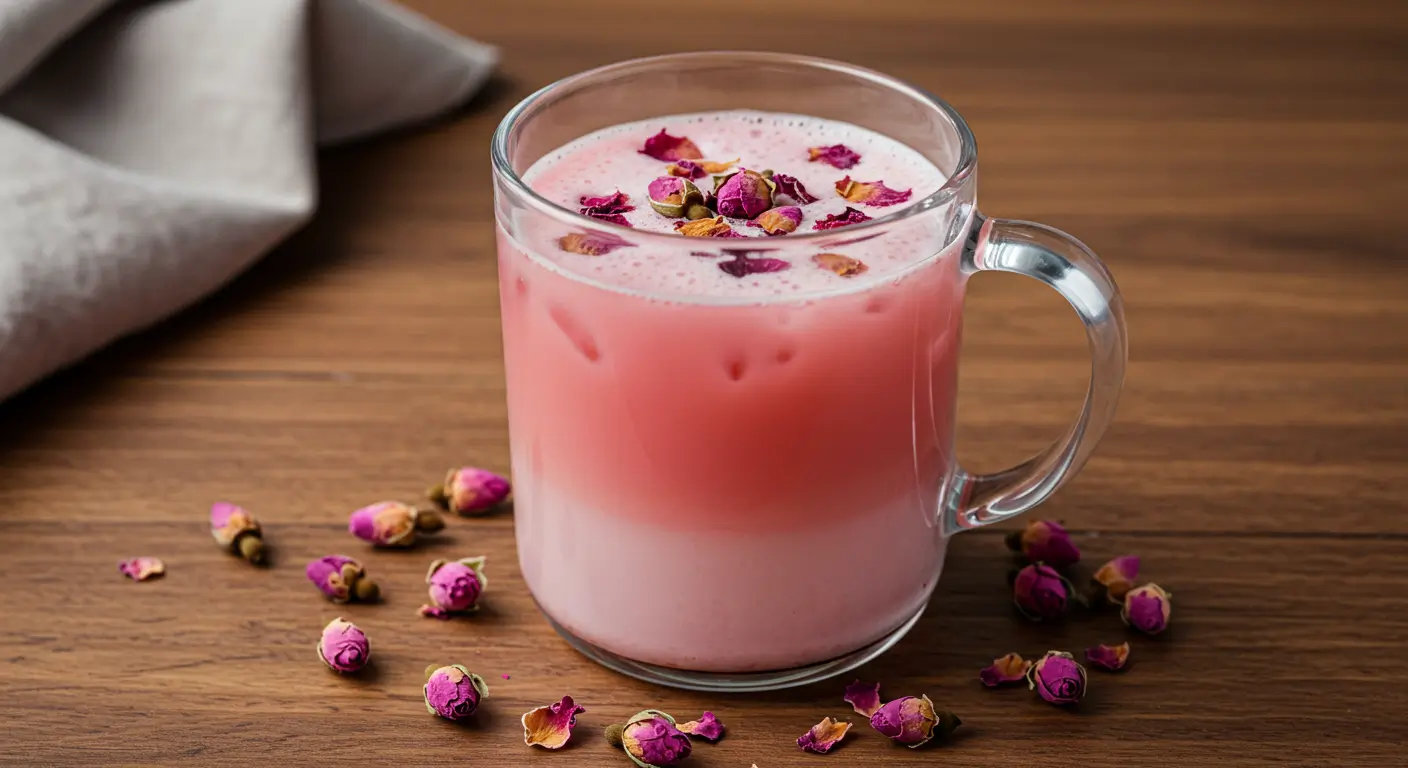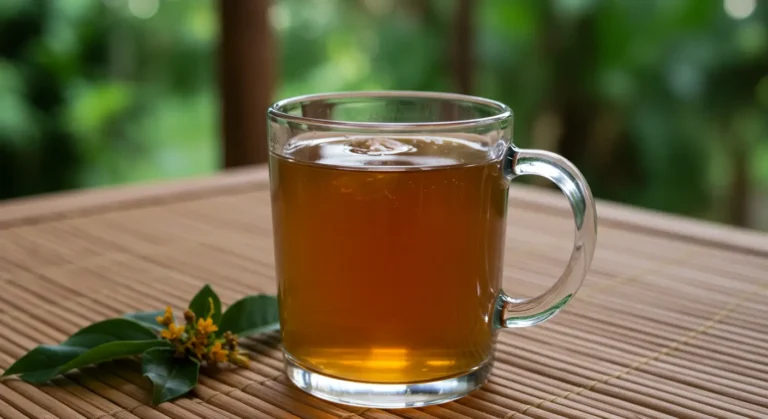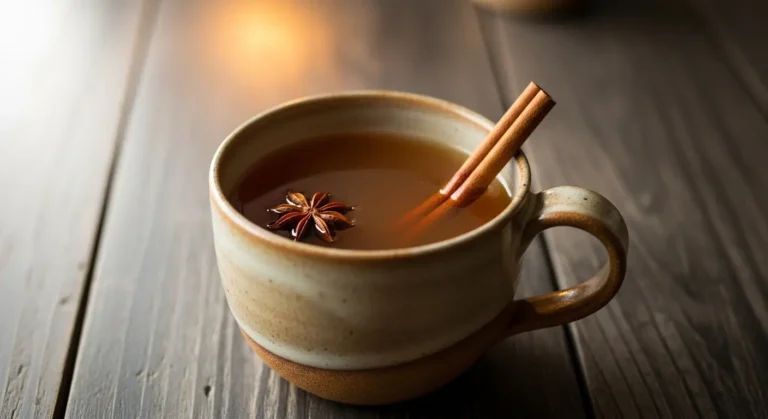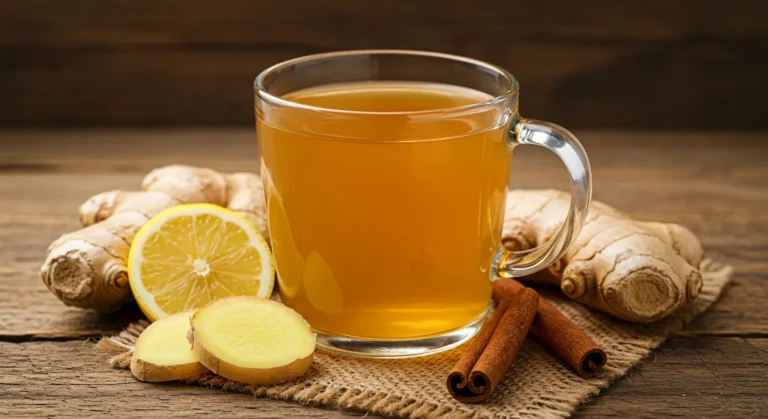Make the Perfect Rose Milk Tea at Home
Rose milk tea consumption has surged dramatically across specialty cafes in recent years, with some shops reporting it as their fastest-growing flavor profile. This aromatic rose milk tea recipe brings the luxurious taste of high-end tea shops right to your kitchen, allowing you to craft this beloved hot drink recipe whenever the craving strikes. The delicate floral notes of rose combined with creamy milk create a soothing experience that tea enthusiasts consistently rank among their favorite comfort beverages.
Table of Contents
Ingredients List
For the perfect rose milk tea, you’ll need:
- 2 tablespoons of high-quality black tea leaves (Assam or Ceylon work best)
- 2 tablespoons of dried rose petals or 1 tablespoon rose syrup
- 2 cups of filtered water
- ½ cup of whole milk (or milk alternative)
- 2-3 tablespoons of honey or sugar (adjust to taste)
- ¼ teaspoon vanilla extract (optional)
- Ice cubes (if serving cold)
- Dried rose petals for garnish
Timing
- Preparation time: 5 minutes
- Brewing time: 10 minutes
- Total time: 15 minutes
Step-by-Step Instructions
Step 1: Prepare Your Tea Base
Heat your filtered water until it reaches a rolling boil. For the perfect rose milk tea, water temperature matters—boiling water helps extract the full flavor from both the tea leaves and rose petals. Once boiling, remove from heat and let rest for 30 seconds if using more delicate teas.
Step 2: Steep the Tea and Rose Petals
Place your black tea leaves and dried rose petals in a teapot or heat-resistant container. Pour the hot water over them and cover with a lid to trap the aromatic compounds. Allow the mixture to steep for 5-7 minutes, depending on how strong you prefer your rose milk tea base. The longer you steep, the more pronounced the flavors will become.
Step 3: Strain the Tea Mixture
Using a fine-mesh strainer, pour the tea into another container, removing all tea leaves and rose petals. This creates a smooth base for your rose milk tea without any unwanted particles. If you’re using rose syrup instead of petals, you’ll add it in the next step.
Step 4: Add Sweetener
While the tea is still hot, add your chosen sweetener. The heat helps dissolve honey or sugar completely, ensuring even sweetness throughout your milk tea. Stir thoroughly until fully incorporated. If using rose syrup, add it now as it acts as both flavoring and sweetener.
Step 5: Warm the Milk
In a small saucepan, gently heat your milk until it’s warm but not boiling. Heating destroys the delicate proteins in milk that contribute to the creamy texture of rose milk tea. If you’re creating a signature milk tea for guests, warming the milk separately allows each person to adjust the milk-to-tea ratio to their preference.
Step 6: Combine and Finish
Pour the warm milk into your tea mixture and add the vanilla extract if using. Stir gently to incorporate all elements into a harmonious rose milk tea blend. The vanilla enhances the floral notes without overpowering the signature rose flavor.
Step 7: Serve and Garnish
Pour your completed milk tea into preheated mugs or glasses. Garnish with a sprinkle of dried rose petals on top for a visual presentation that elevates your homemade rose milk tea to café-quality status. For iced version, let the mixture cool completely before pouring over ice.
Nutritional Information
One serving (approximately 8 oz) contains:
- Calories: 120-150 (depending on sweetener amount)
- Protein: 3g
- Fat: 3.5g
- Carbohydrates: 18g
- Sugar: 15g (varies with sweetener)
- Calcium: 10% of daily recommended value
- Antioxidants: Present from both tea and rose petals
Healthier Alternatives for the Recipe
Transform your beverage into an even healthier beverage with these modifications:
- Reduce Sugar Content: Use half the recommended sweetener and enhance with a cinnamon stick during brewing for natural sweetness
- Dairy-Free Option: Substitute with unsweetened almond milk or oat milk for a lighter milk tea that retains the creamy texture
- Caffeine-Free Version: Use white tea instead of black for a lower caffeine version, or switch to caffeine-free rooibos entirely
- Immune-Boosting Addition: Add a thin slice of fresh ginger during steeping for a rose milk tea with added anti-inflammatory benefits
- Heart-Healthy Swap: Use monk fruit sweetener or stevia instead of sugar for a low-glycemic rose milk tea alternative
Serving Suggestions
Elevate your experience with these serving ideas:
- Pair with shortbread cookies or madeleines for a traditional afternoon tea setting
- Serve in clear glass mugs to showcase its beautiful color
- For summer gatherings, prepare a rose milk tea concentrate and offer it with different milk options at a self-serve beverage station
- Create a rose milk tea flight by preparing three variations: classic, honey-lavender, and cardamom-infused
- For special occasions, rim your rose milk tea glasses with pink sugar mixed with crushed dried rose petals
- Consider serving alongside light pastries like macarons or scones that complement rather than overpower the delicate rose milk tea flavor
Common Mistakes to Avoid
Prevent these typical errors when preparing your drink:
- Using Boiling Water for Milk: Adding boiling water directly to milk causes curdling. Always warm milk separately or allow tea to cool slightly before combining.
- Over-Steeping: Leaving tea leaves too long (beyond 7 minutes) extracts bitter tannins that can overpower the delicate rose flavor.
- Using Low-Quality Ingredients: The rose element is central to this beverage—using artificial rose flavoring instead of natural petals or pure syrup results in a chemical-tasting rose milk tea.
- Adding Rose Flavor Too Late: Rose essence needs time to infuse properly; adding it at the very end produces uneven flavor distribution throughout your milk tea.
- Incorrect Storage of Ingredients: Dried rose petals lose their aromatic compounds when stored improperly. Keep them in an airtight container away from light to maintain potency for future preparations.
Storing Tips for the Recipe
Maximize your rose milk tea experience with these storage recommendations:
- Freshly Made Rose Milk Tea: Store any leftover rose milk tea in an airtight container in the refrigerator for up to 48 hours. The flavor actually develops further overnight, creating a more integrated rose milk tea by the next day.
- Tea Concentrate: Prepare a concentrated version of the rose milk tea base (without milk) and refrigerate for up to 5 days. Dilute with freshly warmed milk when ready to serve.
- Frozen Tea Cubes: Pour leftover rose milk tea into ice cube trays and freeze. These cubes make excellent additions to regular iced tea or can be blended for a quick rose milk tea smoothie.
- Ingredient Prep: Create ready-to-use tea bags by combining black tea leaves and dried rose petals in small muslin pouches, storing them in an airtight container for up to 3 months.
- Homemade Rose Syrup: If you make your own rose syrup for this recipe, it can be preserved in the refrigerator for up to 2 weeks or frozen in small portions for up to 3 months.
Conclusion
This recipe transforms simple ingredients into a luxurious beverage experience through careful brewing and authentic rose flavor. By following these detailed steps and avoiding common pitfalls, you’ll create a perfectly balanced rose milk tea that rivals specialty cafés. The versatility of this recipe allows for personal adaptation while maintaining the essential character of a beloved treat worldwide.
Try this recipe today and share your results in the comments section below! We’d love to see your creative variations and garnishing ideas for this classic recipe.
FAQs
Can I use rose essential oil instead of rose petals ? No, never use essential oils in food preparation unless they’re specifically labeled food-grade. For rose milk tea, stick to culinary-safe ingredients like dried food-grade rose petals, rose syrup, or rose water.
Why does my milk tea taste bitter? Bitterness typically comes from over-steeping the tea leaves or using water that’s too hot. Try reducing steeping time to 3-5 minutes and letting water cool for 30 seconds after boiling before brewing.
Is this recipe caffeine-free? Traditional rose milk tea contains caffeine from the black tea base. For a caffeine-free version, substitute with rooibos or herbal tea instead.
Can I prepare rose milk tea with fresh rose petals from my garden? Only if you’re certain they’re unsprayed and free from chemicals. Most home garden roses are treated with products unsafe for consumption. For rose milk tea, commercially available culinary-grade dried rose petals are the safest option.
What’s the difference between rose milk tea and regular milk tea? Rose milk tea incorporates floral elements that add aromatic complexity not found in standard milk tea. The rose component creates a distinctive flavor profile that’s simultaneously fragrant, sweet, and slightly tannic.
Can this be prepared as a cold beverage? Absolutely! this recipe works beautifully as a cold drink. Prepare as directed, then chill thoroughly before serving over ice for a refreshing twist on the traditional hot version.
Your Feedback Matters
There are no reviews yet. Be the first one to write one.







